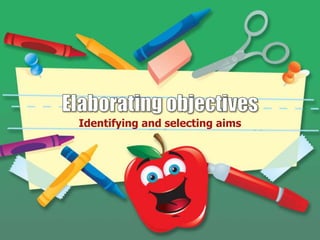
Selecting aims & classroom management
- 1. Identifying and selecting aims
- 2. How do we define aims? Aims are what we want learners to learn or to be able to do at the end of the lesson, a sequence of lessons or a whole course. (Pulverness, 2005 p.86)
- 3. Aims may focus on: A function A grammatical structure Developing a skill
- 5. Main aim Subsidiary aims Personal aims To practise making polite requests in the context of making holiday arrangements. Example exponent: Could you give me some information about hotels? Grammar: to revise modal auxiliary verbs. Functional exponents: Could/Would you…? Vocabulary: to consolidate lexis for travel accomodation. Phonology: to focuus on intonation Speaking: to give controlled oral practice. To improve my organization of the whiteboard and give clearer examples
- 6. It describes the most important thing we want to achieve in a lesson or sequence of lessons. Main aim Reinforce Consolidate UnderstandPractice
- 7. It shows the language learners must be able to use well in order to achieve the main aim. It enables us to see how the lesson should develop from one stage to the next. Subsidiary aim
- 8. Show what we would like to improve or focus on in our own teaching. Personal aim
- 10. The procedures in the table below show a sequence of activities for a lesson with the main aim of developing intermediate students’ confidence and skill in informal conversation. The subsidiary aims for the lesson are in the wrong order. Put them in the right order so that they match the correct procedures. Procedure Subsidiary aims 1. Students move around the classroom to find students with matching halves of sentences. 2.They talk in pairs about what they find difficult in listening to informal conversaton. 3.They hear an informal conversation and identify speakers, place and situation. 4.They listen again and fill in missing phrases in the transcript. A • to listen for detailed information • to focus students’ attention on target language B • to practise gist listening • to create a context C • to get students actively involved • to put students into pairs D • to raise awareness of what the lesson aim will be • to encourage personal involvement
- 12. Planning a lesson When we plan an individual lessson, we need to think about its aims and the kind of techniques that are most appropriate for a particular group of learners.
- 13. We need to think about: Connections between the aims of the lesson and the procedure we will use to achieve those aims The available materials The length of the lesson
- 15. Will the topic be interesting and motivating for my learners? Are the activities and teaching materials at the right leve for all the learners? Have I planned too much for the time available? Have I thought about exactly how to start and end the lesson?